You might take clean water for granted, but it is no easy task getting it to taps throughout the country. Workers within the water and wastewater treatment industry often work alone and at a high risk as they encounter various threats such as slips, trips and falls as well as exposure to gas hazards. It is crucial these workers take additional safety precautions as risk to hazardous gas is undetectable without the use of special equipment.
Lone workers can not rely on others to help them if they face a problem, therefore it is even more important to identify hazards your lone workers may come in contact with in order to protect them whilst at work.
Gas hazards lone workers encounter
Depending on the task being performed the gas hazards can differ. The most common can be found below:
Water, Storm or Waste Collection: Exposure to oxygen enrichment/ deficiency, combustible gases, hydrogen sulphide and carbon monoxide may occur whilst lone workers are working near wells, manholes, sumps, dams, collection tanks and reservoirs. New often combustible gases can enter safe locations as a result of flooding.
Water Transmission and Distribution: Workers may encounter oxygen enrichment/ deficiency, combustible gases, hydrogen sulphide, carbon monoxide and chlorine gas due to the inspection and maintenance on pipelines or trenches.
Water, Storm or Wastewater Collection: Exposure to hydrogen sulphide, combustible gases and an oxygen deficient atmosphere may be a result of working near wells, manholes, sumps, dams, reservoirs and collection tanks. New combustible or toxic hazards from chemicals may spill or leak into safe locations due to flooding.
Confined Spaces: Workers may encounter oxygen deficiency/ enrichment, combustible or toxic gases such as hydron sulphide, sulphur dioxide, carbon monoxide and ammonia while entering confined spaces. If lone workers are required to enter confined spaces they will require additional equipment and training to ensure their safety.
Lone workers in water and wastewater need connected multi-gas detectors.
Lone workers need personal multi-gas detectors which will connect them to safety contacts quickly in case of an emergency. Gas hazards put lone workers at an extremely high risk as they are working within more isolated areas and often will face multiple gas hazards at once.
Personal multi-gas detectors: These devices will alert the worker if a hazard is detected in order for the worker to have sufficient time to evacuate safely. Real-time connectivity allows safety managers visibility into the conditions the worker is facing. This ensures fast and accurate emergency response when works are in danger and need help.



